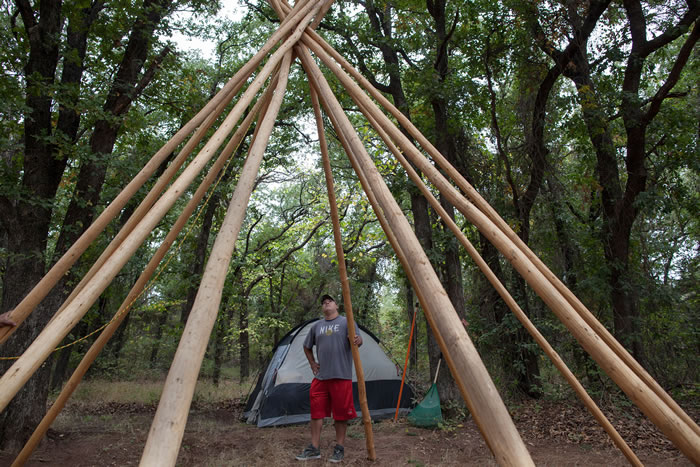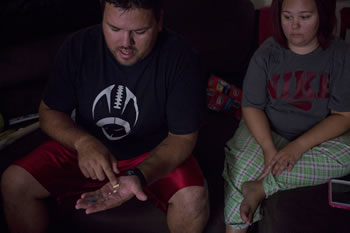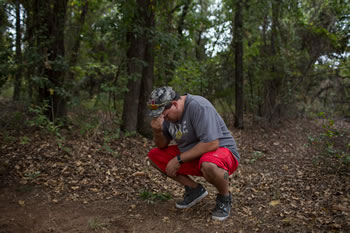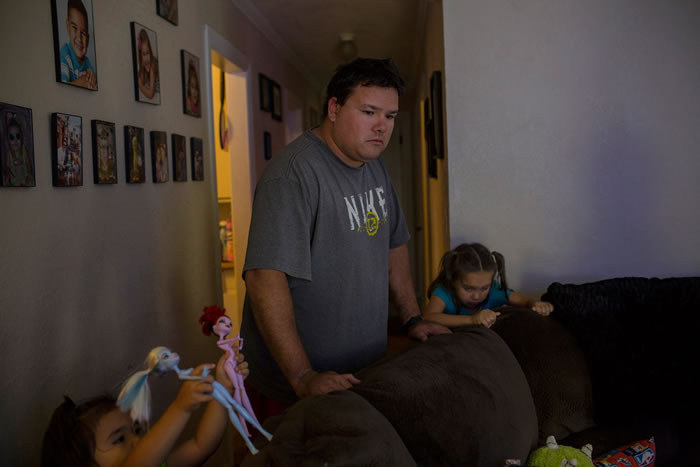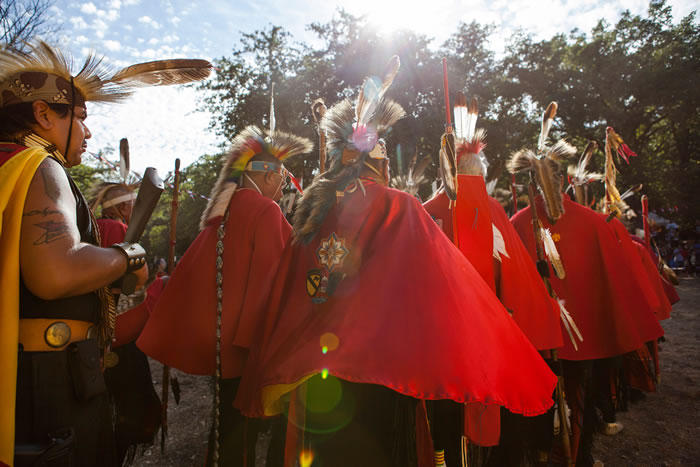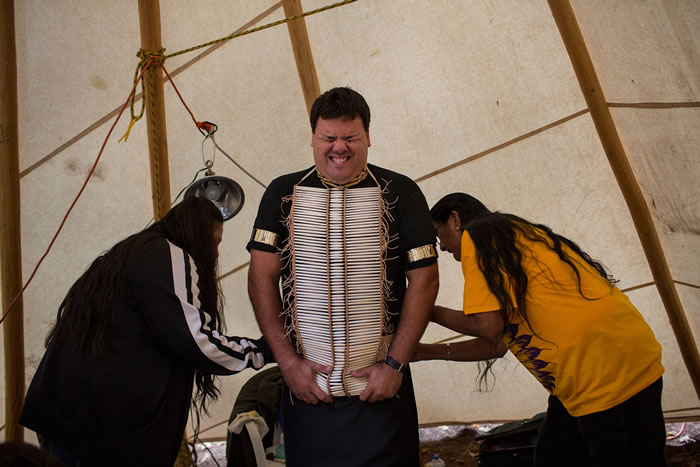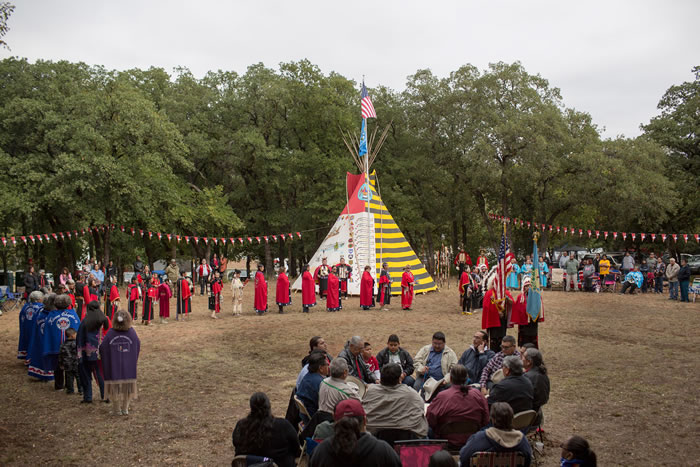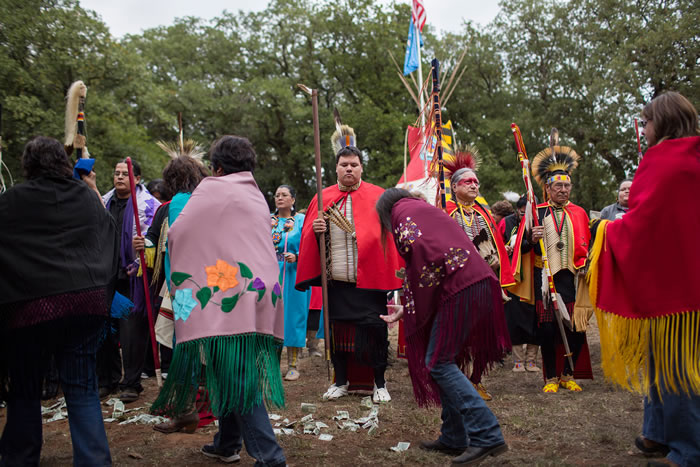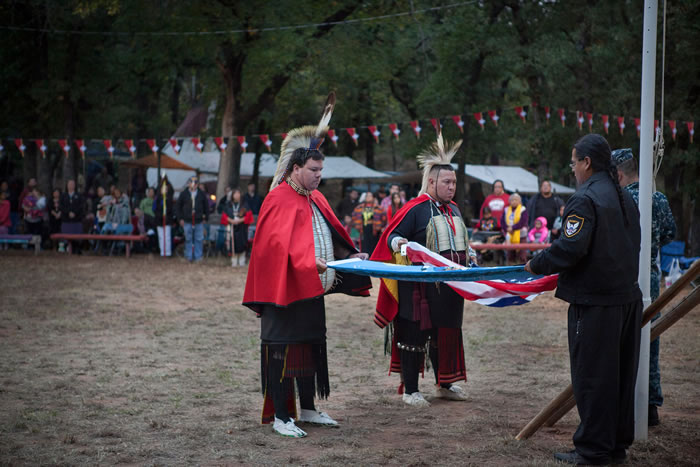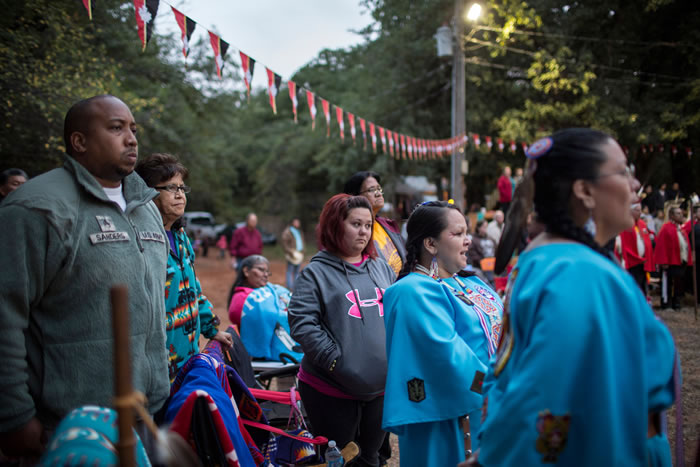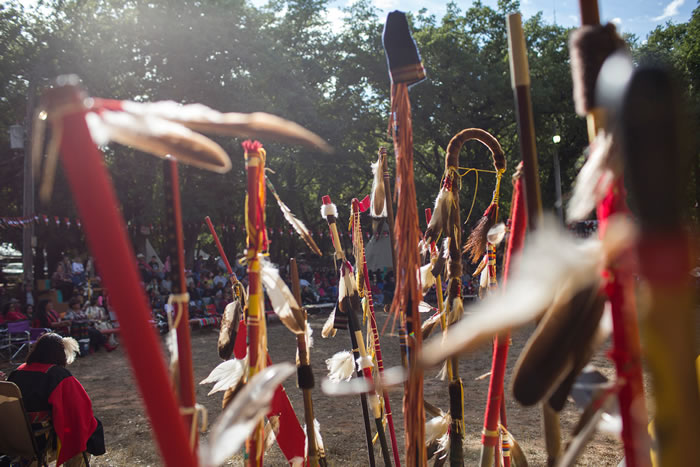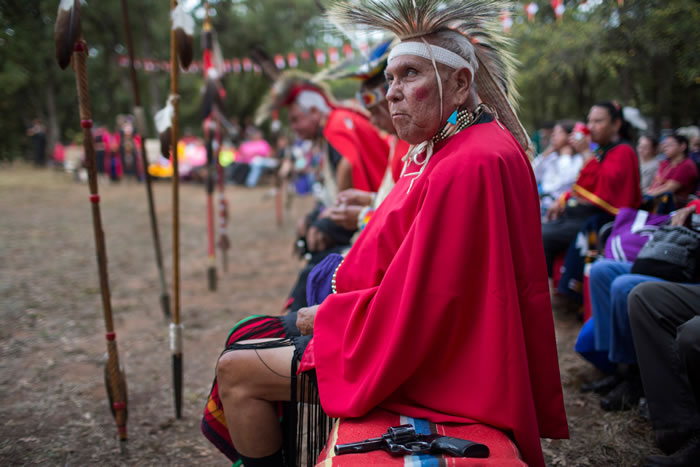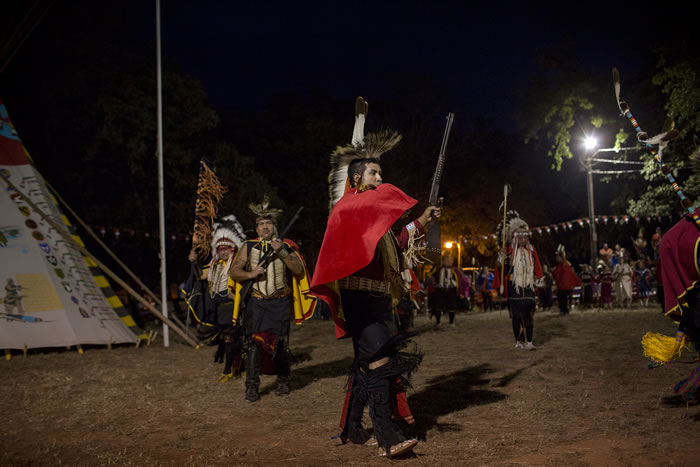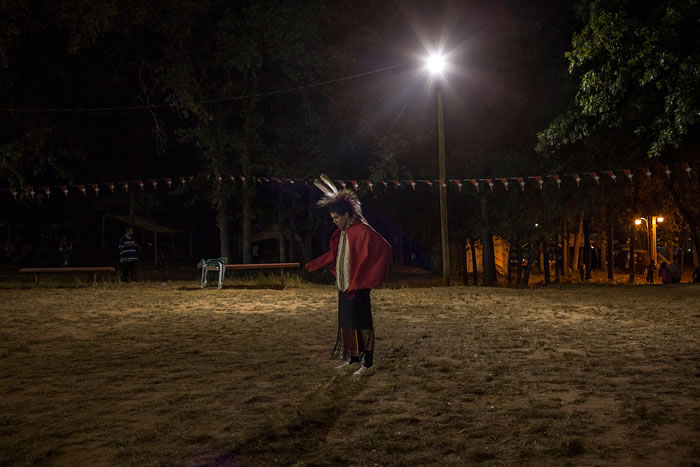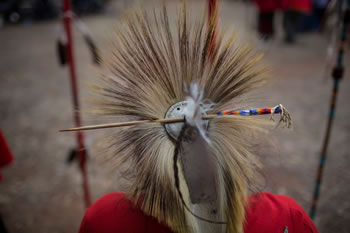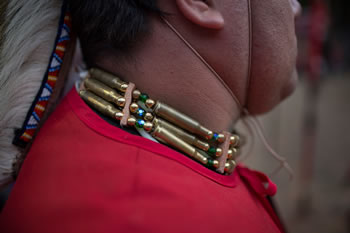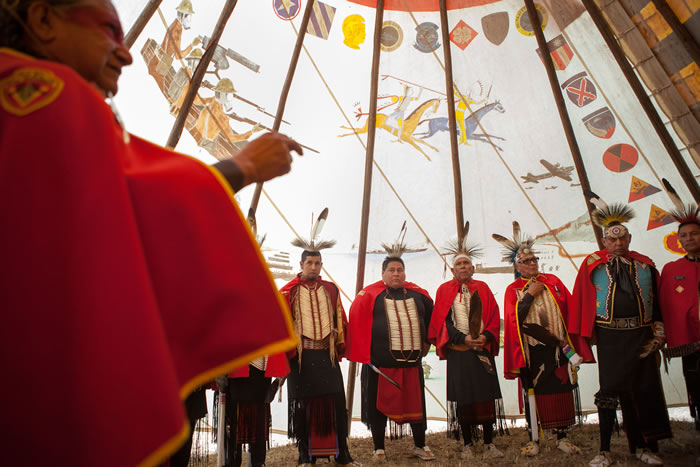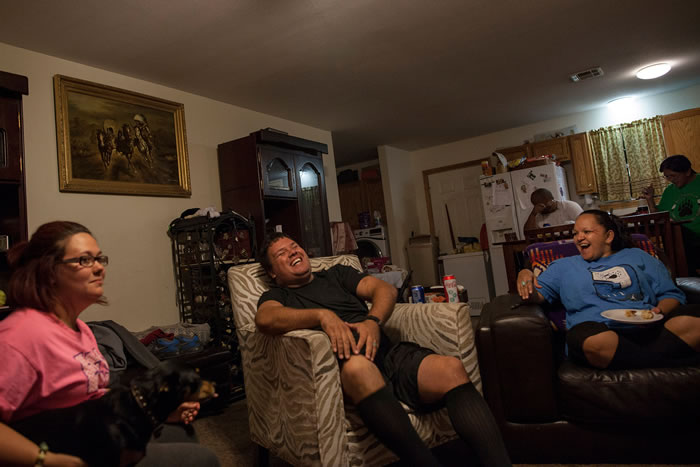 |
Canku Ota
|
 |
|
(Many Paths)
|
||
|
An Online Newsletter
Celebrating Native America
|
||
|
November 2014 - Volume
12 Number 11
|
||
|
|
||
|
No Veteran Left Alone
|
||
|
by Tristan Ahtone for
Al Jazeera America
Edited by Katherine Lanpher, Vaughn Wallace |
||
|
credits: Photos by Nicole
Tung for Al Jazeera America
|
|
The Kiowa tribe of Oklahoma honors its warriors with a ceremony more than 300 years old ANADARKO, OK. — Michael Sankadota's face was clean-shaven and round. He wore black shorts, tennis shoes and a gray University of Oklahoma t-shirt. Around him were men wearing red capes, bone breastplates, long breechcloths, porcupine-hair headdresses and eagle feathers. Their legs were encased in black cloth. An autumn sky hung over the outdoor arena, carved out from a copse of oaks and hickories, and lined with concrete bleachers painted orange. A light wind ruffled dry leaves and stirred the men's capes as they lined up to enter the arena to dance. Family members, veterans and spectators stood up from the bleachers and on all style of outdoor folding chair as a silence settled over the arena and through the woods. Then an old song rose from the throats of the Kiowa Black Leggings Warrior Society members. Lances in hand, they danced their way into the arena, one step at a time in a column, eagle feathers waving in the wind. Sankadota joined them, but as a new member he had to wait one more day before he could change from his civilian clothes into the dress of the Black Leggings — the uniform of the Black Leggings Warrior Society Ceremonial, held every October in this town just 50 miles southwest of Oklahoma City.
When Sankadota, an Iraq War veteran, was asked to join the Black Leggings, he said yes immediately. "My kids will look at me different, like, daddy's this now, he's a part of something bigger" he says, "and it feels a lot bigger than just what I am as a veteran." For as long as anyone can remember, veterans have held one of the most revered places in the culture of the Kiowa Tribe of Oklahoma. The ceremonial is the crowning manifestation of the tribe's attitude toward its warriors. "In American society, when the war is over, you've got your ticker-tape parade, you've got your speeches, and you've got Memorial Day and Veterans Day, and that's pretty much it," says Dr. William Meadows, a professor at Missouri State University and author of "Kiowa Military Societies." "Here, it's never-ending. Once you're a veteran, that respect is always given to you. "Participants must be Kiowa tribal members, and they are heirs to a legacy stretching back centuries to a time known only through oral history. A time before English. Before the state of Oklahoma. A time when the society was known only by its Kiowa name: Ton-Kon-Gah. On the surface, the Black Leggings celebrate warrior culture, but at its core, the society offers a lesson to the next generation of tribal members on what it is to be a Kiowa in a changing world. "Every culture has values and beliefs and ideology, but there's always a handful of things that are more important in that particular culture than the others," says Williams. "One of them, in this culture, is the importance of the veteran."
"This ceremonial is just like a regiment, a company of men," says Warren Queton, a Black Leggings member. "Nobody goes to war on their own; you have other men that you fight alongside with. "The Black Leggings Society is the premier veterans organization of the Kiowa Tribe of Oklahoma and one of the most conservative tribal military societies in existence in terms of retention of traditional practices. While the type of service has changed — from fighting cavalry or other tribes to combat in the South Pacific or the Middle East — members are still soldiers and dual citizens protecting their land and people as well as the United States. The Black Leggings have a saying, Queton says: "I need you and you need me." "There's a lot of truth to that, because even in this ceremony, not one person does it on their own," he says. "You have to have support, just like going into a battle. "Ton-Kon-Gah roughly translates to "black legs group," and there are several stories about how they got their name. "One is that we went on raids and horse-stealing expeditions on foot," says Blas Preciado, Black Leggings vice-commander. "When we came back through the prairies, our legs were black with dirt and sweat." Another story is that the men got the name after an enemy tribe lit the prairie on fire in an attempt to smoke out members. "They made it through the fire and came back and they were just black with ashes, and that's how they got their name," says Dorothy Whitehorse-Delaune, a member of the Kiowa War Mothers, an auxiliary support group for the Black Leggings. "Otherwise they would have been the Dog Soldiers or something. "In 1890, the Black Leggings stopped dancing. The reasons for this are unclear. However, in 1912, they began again with the help of a handful of tribal members, including Michael Sankadota's grandfather. But with the Indian Wars long over, and only a dozen or so Kiowa tribal members who participated in World War I, membership was small. "They held the ceremony in the woods," says Preciado. "That was in the 19-teens when there was an effort by the government to stop dancing of all kinds, including Black Leggings. "Then, the society went dark again until 1958. That's when some of the veterans who had returned from World War II decided to revive what had been a great battle organization. "It came back greater than it was when it died out," says Whitehorse-Delaune. Around 300 Kiowas served in World War II, and Whitehorse-Delaune was one of the revived organization's founding charter members. "Oh goodness, that arena used to be full of hollering," she recalls. "When I think about it now, we're just the dregs of all that, but still, we're going to keep on. It just fills you with pride."
Michael Sankadota has not gone a day without a headache for nearly a decade. Sometimes he forgets where he's going when he's out running errands. If he's away from home for more than a day, he carries a small suitcase full of medication in order to deal with migraines, depression, blood pressure and other ailments. Diagnosed with a traumatic brain injury (TBI) in 2010, Sankadota is just a step away from switching his pills and occasional electric shock therapy for injections into the skull to deal with the pain. His convoy in Iraq was a frequent target of roadside bombs or improvised explosive devices, known as IEDs. His truck alone was hit three times in his first tour. "I had three concussions go untreated," he recalls. Sankadota also suffers from post-traumatic stress disorder, which makes him antsy, tense and unable to be still for long periods of time. Crowds make him nervous, movies are hard to sit through, and it can be set off by any number of things. "Loud booms, cracks, gunshots, flashes, like from a cigarette lighter," he says. "When I tense up, all the blood rushes to my head and then my head starts hurting, and then all of a sudden my migraine starts."
Sankadota is fully disabled and cannot work anymore. When he undertakes physical activities, his head begins to hurt, and usually it ends with him in bed trying to manage the pain. "Sometimes it feels like I'm defeated, that I'm not a man anymore because I can't provide for my family," he says. "The way people look at me, the whole stigma of being a disabled veteran and that you don't want to work. I tried to work. "Sankadota joined the Army in high school, following his sister's example, and served as a cavalry scout in Iraq. He planned to make a career of the military. Instead, he got out in 2008, well short of his goal, due to his injuries. Growing up, he had never heard of the Black Leggings, spoke almost no Kiowa, and felt disconnected from his culture. That feeling continued through the military and into his adult life. He's been back in Oklahoma for only a few years with his family, and is only now discovering his culture and family lineage — the good and the bad. "It's important to me to [join Black Leggings] for my kids so they learn what their culture is and who their family is and to bring luster back to our name," says Sankadota. "It's almost like I have to do it because I want my family to be looked at in a whole different way. "Everything the Black Leggings Warrior Society does emulates something from ancient times. Society dress has remained remarkably unchanged since the 1870s, when the group's customs first began to be documented. For example, the red cape pays tribute to a member who took a similar cape off a Mexican officer during a raid. Since then, members have worn them to commemorate wartime exploits.
Many members also wear a ghom-awdle-haun-gha, or hair plate, that hangs from the back of members' heads — long leather sashes that hover just above the ground with round, metal disks attached to simulate coins. "The Kiowa raided a wagon train that had money, and when they got the coins, they didn't know what it was," says Preciado. "Kiowa men would put it in their hair and in braids and in horse braids for decoration." The society's battle teepee shows how the organization has grown and evolved. The names of all Kiowas killed in combat since World War II are listed, and military unit patches of all its members are painted on. Half the teepee is black- and yellow-striped, the other half covered in combat pictographs. "One of the scenes is a ledger drawing, and it depicts a Kiowa warrior in a battle with Kit Carson. This particular battle scene depicts a Kiowa fighting a Ute chief with a war bonnet on," says Preciado, pointing out each image. "Then we have scenes from World War II; we have a battleship; we also have a scene of Marines landing on one of the Pacific Islands." D-Day is also pictured, as well as Huey helicopters hovering over paddy fields in Vietnam, and finally, Kiowa soldiers standing over the body of a dead Iraqi with a grenade launcher. Dance is the primary feature of the Black Leggings' yearly ceremonial, with scalp dances, shuffle dances and the turn-around dance, which is performed only once a year by Black Leggings members, at the end of the ceremonial on the final day. "This is our dance, this is our language, this is our spirit, and this is an expression of that spirit," says Warren Queton. "That's what makes us different from other organizations or white America: They honor their veterans; we have a ceremony, and that spirit comes out through that ceremony."
On the last day of the ceremonial, the sun had set and the sky was brought low until it seemed to be supported only by the tops of trees and tall poles crowned by glowing spotlights. In the arena, there was no one else — just Michael Sankadota and the rest of the men. The drum began and a host of men's and women's voices sang up toward the ear of the settling night as the turn-around dance began. Known as tsat-koi-gha in Kiowa, the dance serves as a reenactment of a battle that occurred in Texas in the early 1800s as Black Leggings warriors — outnumbered and seemingly defeated by another tribe — were able to carry out a series of counterattacks and escape without a casualty. The "turn around" refers to the counterattacks made during the battle. The tempo began to increase, as did the Black Leggings' dance pace. A man held a revolver in the air and fired a round off. Then another raised a rifle above his head and pulled the trigger. Michael Sankadota's head was lowered, his knees were bent, and his feet kept time with the increasing tempo. Another man fired a gun in the air and the song got faster. War whoops were bellowed and the spotlights burned brighter and brighter. The lines of men circling the arena changed direction; they fired their guns in the air, then changed direction again. The tempo grew faster and faster and they danced harder and harder, just like their fathers had done, and their grandfathers, and family members whose names could no longer be remembered.
A shot rang out. Porcupine-hair headdresses and red capes bounced to the beat and the song grew even more intense. Then, one man stepped forward, raised a lance above his head with one hand and held up a 12-gauge shotgun with the other. War whoops erupted across the arena, the drum stopped and those watching made no noise. Tradition dictates that the turn-around dance continue until a member stops the drum and tells a war story. Army scout Joe Lazano's story began with Desert Storm. His unit, The Big Red One, was one of the first to go into Iraq. "We did what we were trained to do: Go find the biggest dog and piss it off," said Lazano. "We lost two-thirds of our platoon right off the bat and it turned into a slugfest. My friends were screaming over the radios: 'Two's been hit! Two's gone!' Those were my friends, those were my brothers, the ones I had been growing up with. "Lazano paused for a moment; his voice quaked as he recalled his sergeant, who also died. "He did a lot for me. He not only taught me how to be a soldier, but he also taught me how to be a man," said Lazano. "Even when I come back here, I look around and these men are teaching me what I need to know and to carry this on. "War whoops erupted and singers pounded the drum. Then, a brief silence again. Michael Sankadota stood among the men, dressed in his red cape, bone breastplate and porcupine-hair headdress, and his legs and chest were black. His head hurt, but he had managed to push through the entire weekend to become a full-fledged member, and when the ceremonial was over, his son asked how to join. "It feels good," said Sankadota. "Now I don't feel like an outsider looking in. I'm actually a part of it."
|
||||||||||||||||||||||||||||||||||||||||||||||||||||||||||||||||||||||
|
|
||
|
|
||
| Canku Ota is a free Newsletter celebrating Native America, its traditions and accomplishments . We do not provide subscriber or visitor names to anyone. Some articles presented in Canku Ota may contain copyright material. We have received appropriate permissions for republishing any articles. Material appearing here is distributed without profit or monetary gain to those who have expressed an interest. This is in accordance with Title 17 U.S.C. Section 107. | ||
|
Canku Ota is a copyright ©
2000 - 2014 of Vicki Williams Barry and Paul Barry.
|
||
 |
 |
|
|
The "Canku
Ota - A Newsletter Celebrating Native America" web site and
its design is the
|
||
|
Copyright ©
1999 - 2014 of Paul C. Barry.
|
||
|
All Rights Reserved.
|
||

